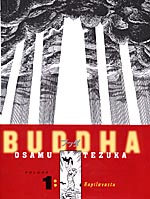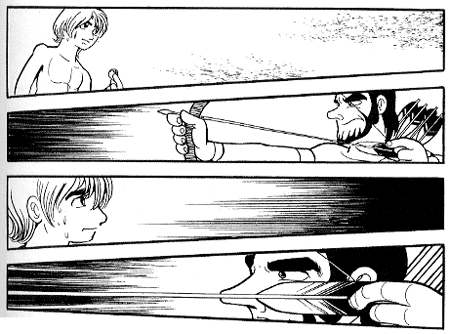 By Osamu Tezuka
By Osamu Tezuka
400 pages, black and white
Published by Vertical, Inc.
It’s hard to believe that just a couple of years ago, it was almost impossible to find works by Osamu Tezuka in English. Considered by many to be the father of comics in Japan, his English canon consisted primarily of Adolf and Black Jack. Now, it seems, America is finally catching up with the rest of the world. In the past five years, we’ve seen Tezuka inducted into the Eisner Awards’s Hall of Fame, and translations of Phoenix, Astro Boy, Nextworld, and Metropolis just the tip of the iceberg. Now book publisher Vertical, Inc., already publishing translations of Japanese prose novels, is publishing Tezuka’s eight-volume opus Buddha.
A Brahmin monk is search of the Great One, a boy born with great intelligence and wisdom that is promised to have insights to make the rest of the Brahmin pale in comparison. When he arrives at the village of his search, he discovers that the boy that might be the Great One is a wily scamp… and born to the lowest social caste of all. Could this really be the Great One? Or is he just the harbinger to something greater?
Like Adolf, Tezuka’s Buddha takes real world events and mixes fictional characters in with our history to create his story. It’s an interesting technique, one that concentrates more on his own creations (Tatta the pariah, Chapra the slave, and so forth). By doing so, he’s able to tell a story that will both interest those who know about the Buddha’s life already (there’s not much suspense in a story that you already have heard before) and those who know nothing (since you’ll learn a lot about Buddha through these other characters’s eyes). Tezuka’s story of warlords and slavery will certainly bring to mind his book Phoenix: Dawn, where Tezuka’s dislike of conquerors is also on display. To Tezuka’s credit, he’s able to make General Budai much more rounded than one might have suspected; while Budai’s profession may make readers hate him, he’s certainly capable of love and affection and proves to be a good if stern father. Buddha is the sort of book that will live or die based on its characters, and Tezuka makes it live life to its fullest.

Those who have read some of Tezuka’s other works will know what to expect with his art in Buddha. It’s a very cartoonish depiction of characters, but still capable of great emotion. A cross look, a tentative smile, a gasp of horror… just because they’re stripped down in how many lines that Tezuka uses doesn’t mean it’s any less powerful an emotion. It’s also nice because for anyone who’s never read comics before, Buddha won’t distract them from the story at hand. His characters are iconic because of the stripped-down art style, allowing readers to project faces and people onto the characters at hand. The storytelling is also great for newer readers because it’s extremely easy to follow. There’s a very clear and natural flow of panels, but Tezuka’s still able to play small visual tricks on the reader. A scene with Chapra facing down an archer, for instance, uses narrow slanted panels that pull the reader’s eye back and forth, emphasizing both the distance between the two of them as well as the rock and arrow that are both about to fly at their targets.
The first volume of eight, it’s hard to believe that after 400 pages we’re only at the edge of the greater waiting to be told; Tezuka does a lot of setting up for his characters in the books to come, while still keeping enough in Buddha Vol. 1: Kapilavastu to keep your interest through what could almost be considered a prologue. All I know is that I finished this first book immensely satisfied and ready to run out and buy the second volume. Just make sure you do; with an attractive cover design by Chip Kidd, these books are going to fly off the shelves. These are books you’ll definitely want to have gracing your shelves.
Purchase Links:
